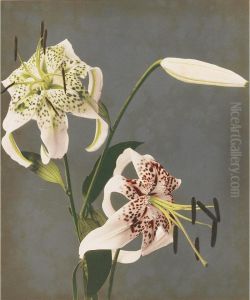Kasumasa Ogawa Paintings
Kasumasa Ogawa was a prominent Japanese photographer and printer during the Meiji and Taishō periods in Japan. He was born on November 19, 1860, in Saitama Prefecture, and is best known for his pioneering work in photomechanical printing and photography, particularly collotype printing, which allowed for high-quality photographic reproductions.
Ogawa was educated at the Imperial College of Engineering in Tokyo, where he studied under British photography instructor W.K. Burton. He developed an interest in photography and printing technologies during his studies. In 1880, he moved to the United States, where he continued to study photography in Boston for four years. During his time in the US, he honed his photographic skills and gained a deep understanding of photomechanical reproduction techniques.
After returning to Japan in 1884, Ogawa opened a photographic studio in Tokyo. He became a leader in developing the photography industry in Japan, producing portraits, landscapes, and documentation of cultural events and traditional Japanese life. However, his most significant contribution to the field was in the area of printing. In 1889, he established the first collotype business in Japan, the Ogawa Shashin Seihan jo (Ogawa Photography Production Company), which became famous for its high-quality work.
Ogawa was also instrumental in the publication of important cultural and pictorial works, such as 'Nihon Sankei' (Japan's Three Famous Views) and 'Costumes of Japan'. His publications played a significant role in popularizing Japanese culture and imagery internationally. He contributed to the promotion of Japanese art and aesthetics during a period when Japan was opening up to Western influence and technology.
Throughout his career, Ogawa was involved in various organizations, including serving as a founding member of the Japan Photographic Society. His work in photomechanical printing not only established him as a leading figure in Japanese photography but also contributed to the spread of Japanese visual culture worldwide.
Kasumasa Ogawa's dedication to his craft and his role in the development of photographic technology in Japan left a lasting impact on the world of photography and printing. His legacy can be seen in the continued use of some of his techniques and in the rich visual documentation of Japan during the Meiji and Taishō eras. Ogawa passed away on September 7, 1929, leaving behind a body of work that continues to be appreciated for its artistic and historical significance.
